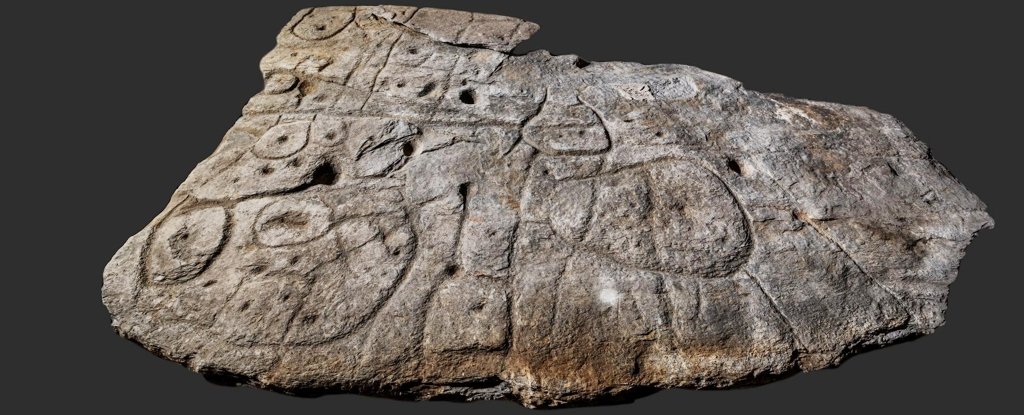
Posted on 10/18/2023 12:42:02 PM PDT by Red Badger

The Saint-Belec slab. (D. Gliksman/Inrap) A piece of rock with mysterious markings that lay largely unstudied for 4,000 years is now being hailed as a "treasure map" for archaeologists, who are using it to hunt for ancient sites around north-western France.
The so-called Saint-Belec slab was claimed as Europe's oldest map by researchers in 2021 and they have been working ever since to understand its etchings – both to help them date the slab, and to rediscover lost monuments.
"Using the map to try to find archaeological sites is a great approach. We never work like that," said Yvan Pailler, a professor at the University of Western Brittany (UBO).
Ancient sites are more commonly uncovered by sophisticated radar equipment, aerial photography or by accident in cities when the foundations for new buildings are being dug.
"It's a treasure map," said Pailler.
But the team are only just beginning their treasure hunt.
The ancient map marks an area roughly 30 by 21 kilometres and Pailler's colleague, Clement Nicolas from the CNRS research institute, said they would need to survey the entire territory and cross reference the markings on the slab.
That job could take 15 years, he said.
Rivers and mountains Nicolas and Pailler were part of the team that rediscovered the slab in 2014 – it was initially uncovered in 1900 by a local historian who did not understand its significance.
The French experts were joined by colleagues from other institutions in France and overseas as they began to decode its mysteries.
"There were a few engraved symbols that made sense right away," said Pailler.
In the coarse bumps and lines of the slab, they could see the rivers and mountains of Roudouallec, part of the Brittany region about 500 kilometres west of Paris.
The researchers scanned the slab and compared it with current maps, finding a roughly 80 percent match.
"We still have to identify all the geometric symbols, the legend that goes with them," said Nicolas.
The slab is pocked with tiny hollows, which researchers believe could point to burial mounds, dwellings or geological deposits.
Discovering their meaning could lead to a whole flood of new finds.
'Doomed' slab But first, the archaeologists have spent the past few weeks digging at the site where the slab was initially uncovered, which Pailler said was one of the biggest Bronze Age burial sites in Brittany.
"We are trying to better contextualise the discovery, to have a way to date the slab," said Pailler.
Their latest dig has already turned up a handful of previously undiscovered fragments from the slab.
The pieces had apparently been broken off and used as a tomb wall in what Nicolas suggests could signify the shifting power dynamics of Bronze Age settlements.
The area covered by the map probably corresponds to an ancient kingdom, perhaps one that collapsed in revolts and rebellions.
"The engraved slab no longer made sense and was doomed by being broken up and used as building material," said Nicolas.
PinGGG!..........................

Where’s the ale house?
I think the circles are villages, and some of the lines are trails before they had good roads.
Straight lines are probably property boundaries...................
It says ‘We’re putting all the treasure on Oak Island’
I am amazed at what people so long ago did in terms of conceptualizing space!
Whatever it is, it’s interesting.
another very old mysterious map
The Controversial Dashka Stone: 120 Million-Year-Old Map?
https://www.ancient-origins.net/artifacts-ancient-writings/dashka-stone-006589
The Dashka Stone: 120 Million-Year-Old Map of the Creator
https://anomalien.com/dashka-stone-map-of-the-creator/
Nonsense.
It was a prototype for a Ouija board.
Designed by ancestor of Nostradamus.
There are numerous rock/stone anomalous ruins around the earth. Many point to humans being on earth far longer than most anthropologists will admit to. Fun stuff.
FWIW, I don’t believe in ‘ancient astronauts’ from other star systems, so I don’t ascribe ancient artifacts to “extraterrestrials”. But given the quality of workmanship of some of the ancient ruins, it seems to me that humans were quite advanced at some point in the now-distant past.



Thanks Red Badger.
No it says: “Drink Your Ovaltine’’.
Disclaimer: Opinions posted on Free Republic are those of the individual posters and do not necessarily represent the opinion of Free Republic or its management. All materials posted herein are protected by copyright law and the exemption for fair use of copyrighted works.